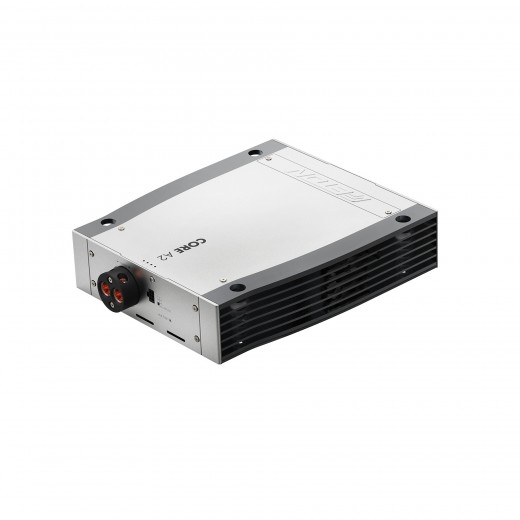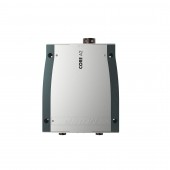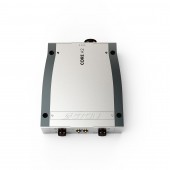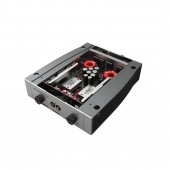Eton CORE A2 amplifier
2-channel, 2 x 138 / 1 x 504 into 4 Ω / 2 x 255 W RMS into 2 Ω, class AB
More about the product
More about the product
Reference dual mono 2-channel amplifier Eton CORE A2
The new CORE A2 is a "State of the Art" Class AB amplifier created for an uncompromising musical experience. Absolutely no frills, everything is hidden inside the amplifier, at its heart. It can produce music absolutely live and without the slightest distortion, you will hear absolutely everything that was recorded in the studio. The amplifier is made from only the best components and its body and some parts are CNC machined to achieve perfect workmanship. The body of the amplifier is made of anodized aluminum. If you want the best, then we offer this amplifier from Eton! Made in Germany.
Key features of the Eton CORE A2 reference amplifier
- 2 x 138 W RMS into 4 Ω.
- Harmonic distortion THD+N @ 1 W RMS < 0.007% / THD @ 1 W RMS < 0.001%.
- Aluminum body.
- Perfect workmanship.
- Using the best components.
- A completely exclusive affair that you will fall in love with.
| Catalog number | CORE A2 |
| Brand | Eton |
| Links | Official web presentation |
| Number of amplifier channelsAmplifiers are divided into: - Monoblocks - 2-channel - 3-channel - 4-channel - 5-channel - 6-channel - multi-channel Each channel is used to power one speaker for the coaxial type, or one side if they are component speakers. Monoblock type amplifiers are mainly used for subwoofers. 2-channel are suitable for both subwoofers and, for example, the front pair of speakers in a car. 3-channel is used for front or rear speakers + subwoofer. 4-channel are used for front + rear speakers or 1 pair of speakers + subwoofer. 6 or 5-channel are used for 2 pairs of speakers + subwoofer, most often. Bridging means connecting the amplifier to a bridge, using the + pole from one channel and the - pole from the other channel. In most cases this is shown as "BRIDGED" on the amplifier. | 2 |
| Energy class of the amplifierAmplifiers are divided into two basic classes: analog and digital . Analog amplifiers (A/B) have higher consumption requirements, but usually have a more natural sound. Digital amplifiers (D) have significantly lower consumption and higher efficiency, but the sound may not be as faithful as with classic analog amplifiers. | A/B |
| RMS power into 4 ΩRMS power when loading speakers or subwoofer at 4 Ω. RMS power is the constant power of the amplifier and is one of the most important parameters when choosing an amplifier. | x 138 / 1 x 504 W |
| RMS power into 2 ΩRMS power when loading speakers or subwoofer at 2 Ω. RMS power is the constant power of the amplifier and is one of the most important parameters when choosing an amplifier. | 2 x 255W |
| Harmonic Distortion (THD)Total harmonic distortion indicates how much the input signal is distorted in the amplifier. Distortions appear as overtones contained in the output signal. The proportion of originally absent parts of the signal is given as a percentage, typical values are between 0.001% and 0.5%. Distortion is measured in their power band. If it exceeds the limit of 0.7% from a certain power, it is the value of the output power of the given amplifier, from which it no longer plays without distortion and from which the distortion usually increases steeply, so that no further increase in power can be counted on. The lower the value, the better. | 0.001% |
| On-board voltage rangeThe ability of the amplifier to operate at a specified voltage. As the voltage decreases, so does the power of the amplifier. The ideal voltage in a car is between 13.8 and 14.4 V. | 6.5 – 15.5 V |
| Socket input terminalsFerrule terminals allow better wiring contact to the amplifier. It is also a more secure form of terminals. If you are tightening the sleeve terminals, we recommend retightening them after 1 day, as the connected cable gradually compresses. | Yes |
| Remote control included in the packageSome models of amplifiers also come with wired remote controls in the package, which on one side plug into the amplifier and on the other side you have a potentiometer that you can place anywhere in the cabin. A common place to place the remote control is under the steering wheel. The advantage is the regulation of power, and therefore volume, depending on driving conditions and the mood of the crew in the car. | No |
| Input for wired remote controlIf the amplifier has a remote control input. | No |
| Dimensions of the amplifier | 283 x 250 x 55 mm |
Product comments
Evaluation
ask us






















